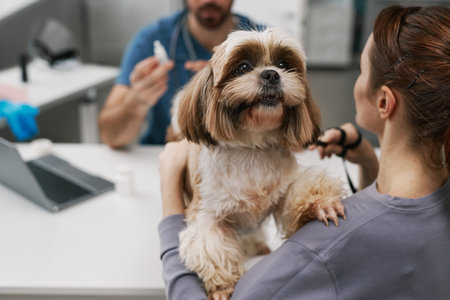Introduction to Pet Microchipping in the UK
In the United Kingdom, microchipping is not just a responsible choice for pet owners—it is also a legal requirement. The practice of implanting a tiny electronic chip beneath a pets skin has become central to animal welfare and responsible ownership across the nation. Since the introduction of microchipping laws, it has been mandatory for all dogs and, more recently, cats to be microchipped by a certain age. This measure aims to ensure lost or stolen pets can be swiftly reunited with their families, ultimately reducing the burden on rescue centres and local authorities.
Microchipping serves as a permanent form of identification, providing crucial details that cannot be easily removed or tampered with like traditional collars and tags. The process itself is quick and minimally invasive, carried out by veterinary professionals or trained individuals. For pet owners, compliance with these regulations demonstrates a commitment to animal welfare and the broader principles of responsible pet stewardship that are highly valued within British society.
The table below summarises key aspects of current UK microchipping laws for pets:
| Pet Type | Legal Requirement | Minimum Age | Penalty for Non-Compliance |
|---|---|---|---|
| Dogs | Mandatory microchipping | 8 weeks | Up to £500 fine |
| Cats (from 2024) | Mandatory microchipping | 20 weeks | Up to £500 fine |
As part of responsible pet ownership in the UK, ensuring your animals are microchipped not only keeps you compliant with the law but also reinforces your role in protecting animal welfare and supporting community efforts to reduce stray populations. The following sections will explore the specifics of these laws, how to comply, and best practices for maintaining up-to-date information on your pets’ microchips.
Current Microchipping Laws and Regulations
The United Kingdom has established clear legislation regarding the compulsory microchipping of pets, particularly dogs and cats. These laws aim to enhance animal welfare, improve lost pet reunification rates, and encourage responsible pet ownership. Below is an overview of the current requirements:
Microchipping Legislation at a Glance
| Pet Type | Legal Requirement | Deadline for Compliance | Key Exemptions |
|---|---|---|---|
| Dogs | Mandatory microchipping for all dogs over 8 weeks old | Since 6 April 2016 (England, Scotland, Wales); Northern Ireland since 2012 | Certified health reasons by a vet |
| Cats | Compulsory microchipping for all cats over 20 weeks old (from June 2024 in England) | 10 June 2024 (England); Not yet mandatory in Scotland, Wales or Northern Ireland as of early 2024 | Certified health reasons by a vet; feral/unowned cats excluded |
Main Legal Duties for Pet Owners
- Ensure timely microchipping: Owners must have their dogs microchipped by 8 weeks of age and cats by 20 weeks (in England).
- Keep contact details up to date: It is a legal obligation to ensure that the information held on the microchip database is accurate and updated if you move home or change phone numbers.
- Use approved databases: Microchip records must be kept with a government-compliant microchip database provider.
- Provide documentation when rehoming: If transferring ownership, relevant microchip details must accompany the pet.
- Comply with enforcement: Failure to comply can result in a notice being served; owners have 21 days to rectify non-compliance before facing fines up to £500.
Exemptions and Special Circumstances
Certain exemptions apply if a veterinary professional certifies that microchipping would adversely affect an animal’s health. Feral and unowned cats are also excluded from the new cat microchipping law in England.

3. How Microchipping Works
Microchipping is a straightforward yet highly effective method for pet identification, and it plays a central role in complying with UK legislation. The process involves the insertion of a tiny microchip, about the size of a grain of rice, just beneath your pet’s skin—typically between the shoulder blades. This quick procedure is usually performed by a vet or trained animal professional and causes minimal discomfort to your pet.
The Microchipping Process
The microchip itself contains a unique identification number, which can be read using a handheld scanner. Here’s a step-by-step overview of how microchipping works in the UK:
| Step | Description |
|---|---|
| 1. Implantation | A sterile microchip is inserted under the pets skin using a specialised needle. |
| 2. Registration | The owner’s contact details and pet information are registered on an approved UK database, linked to the chip’s unique number. |
| 3. Scanning | If the pet is found, vets, rescue centres, or local authorities scan for the microchip to retrieve its ID number. |
| 4. Reunification | The database is accessed using the ID number, allowing contact with the registered owner for reunification. |
What Information Is Stored?
The microchip itself does not store personal data; rather, it holds only the unique identification number. All sensitive information—such as your name, address, telephone number, and details about your pet—is securely stored on an authorised database. It is vital to keep this information up-to-date to ensure you can be contacted if your pet goes missing.
Information Typically Registered on the Database:
- Owner’s full name and address
- Contact telephone numbers (including mobile)
- Email address (optional but recommended)
- Pet’s name, breed, sex, date of birth, and distinguishing features
- Veterinary practice (if applicable)
The Importance of Microchipping for Identification and Reunification
Microchipping provides peace of mind by offering a permanent form of identification that cannot be lost or removed like a collar or tag. In cases where pets become lost or stolen, microchips greatly improve the chances of successful reunification with their owners. Animal welfare organisations and local councils across the UK rely on microchips to trace lost pets quickly and efficiently. Remember: keeping your details updated on the database is essential for compliance with UK law and for safeguarding your beloved companion.
4. Registration and Keeping Details Up to Date
Once your pet has been microchipped, it is a legal requirement in the UK that the microchip’s details are registered on an approved database. Failing to do so can result in fines and may affect your ability to reclaim your pet if they go missing. Below is a guide to ensure you remain fully compliant with UK law regarding microchip registration and maintenance.
Registering Your Pet’s Microchip
Your vet or implanter will typically provide you with a registration form or instructions after microchipping your pet. You must submit accurate information to an approved database—these databases meet the standards set by UK authorities for data security and accessibility. Make sure to keep a copy of the registration confirmation for your records.
Approved Microchip Databases in the UK
It is essential to register your pet’s microchip with an approved database, as not all databases are recognised by UK law. The table below outlines some of the main government-approved databases:
| Database Name | Website | Contact Number |
|---|---|---|
| Petlog | petlog.org.uk | 01296 336579 |
| Animal Tracker | animaltracker.co.uk | 01279 219777 |
| Identibase | identibase.co.uk | 0330 9128077 |
| PETtrac | pettrac.co.uk | 01234 219970 |
The Importance of Keeping Details Up to Date
If you move house, change phone numbers, or transfer ownership of your pet, it is vital that you update the microchip details promptly via the database provider. Out-of-date information could mean you are non-compliant with the law and significantly reduces the chance of being reunited with your pet if they become lost.
How to Update Microchip Information:
- Log in to your chosen database’s website using your account details.
- Select the option to update personal or contact information.
- Enter the new details and confirm changes as instructed.
- If transferring ownership, follow the platform’s transfer process (often both parties need to confirm).
- You may be charged a small administrative fee depending on the provider.
Why Up-to-Date Registration Matters:
- Legal Compliance: It is a legal obligation under UK law for dog owners, and highly recommended for cat owners from June 2024 onwards, to keep microchip details accurate.
- Easier Reunification: If your pet goes missing, up-to-date contact information ensures animal wardens, vets, or rescue centres can reach you swiftly.
- Avoid Fines: Non-compliance can result in fixed penalty notices or prosecution.
The process of registering and maintaining your pet’s microchip information is straightforward but crucial for responsible pet ownership in the UK. Regularly check and update your details to stay compliant and safeguard your beloved companion.
5. Compliance Checks and Penalties
Ensuring pet owners comply with microchipping laws is a key focus for local authorities across the UK. Regular compliance checks are carried out, particularly during dog warden patrols, community events, or when lost pets are reported. Local authorities have the legal power to request proof of microchip registration and accurate information from pet owners. If a pet is found without a microchip or with incorrect details on record, immediate steps must be taken to rectify the situation.
What Happens During Compliance Checks?
- Routine Inspections: Dog wardens or animal control officers may scan pets during park patrols or after complaints from neighbours.
- Shelter Admissions: When stray animals are taken to shelters, they are scanned for a microchip as part of intake procedures.
- Veterinary Visits: Some veterinary clinics also participate in compliance promotion by scanning pets during check-ups and advising owners if their pet is not chipped or if data is outdated.
Penalties for Non-Compliance
If your pet is not microchipped, or if your contact details are not kept up-to-date on the registered database, you could face legal consequences. The table below outlines possible penalties:
| Offence | Action Required | Penalty |
|---|---|---|
| Pet not microchipped | Owner receives a notice to microchip within 21 days | £500 fixed penalty if non-compliant after deadline |
| Incorrect/outdated information on database | Owner must update details promptly (usually within 21 days) | £500 fixed penalty if not updated |
What If Your Pet Is Found Without a Microchip?
- The local authority will issue an enforcement notice, giving you 21 days to comply.
- If you fail to act within this period, you may receive a fixed penalty notice of up to £500.
- If further non-compliance occurs, prosecution may follow, leading to higher fines and potential court action.
Best Practice Tip:
Always ensure your contact details are current on your chosen UK-approved microchip database. If you move house or change phone numbers, update these records promptly to avoid unnecessary fines and ensure your pet can always be safely returned if lost.
6. Best Practices and Tips for UK Pet Owners
Ensuring your pet’s microchip meets UK legal standards involves more than just the initial procedure. Here are some essential best practices and practical tips for responsible pet owners, covering provider selection, accurate record keeping, and lifelong maintenance of your pet’s microchip details.
Choosing a Reputable Microchip Provider
When selecting a microchip provider, it is vital to choose one that is Defra-compliant and uses ISO-standard microchips. Ensure the person implanting the chip is trained and qualified; many reputable veterinary practices, animal charities, and local authorities offer this service. Avoid unregulated providers to safeguard your pet’s wellbeing and legal compliance.
| Provider Type | Defra Compliance | Qualified Implanter |
|---|---|---|
| Veterinary Surgery | ✔️ | ✔️ |
| Animal Welfare Charity (e.g., RSPCA) | ✔️ | ✔️ |
| Pet Shops/Markets | Check individually | Check individually |
Record Keeping: Why Accuracy Matters
Your pet’s microchip is only as useful as the information registered with it. After implantation, ensure your contact details are correctly recorded with an official UK database (such as Petlog or Animal Tracker). Any errors can delay reunification if your pet goes missing.
Key Steps for Effective Record Keeping:
- Register your pet’s microchip immediately after implantation.
- Keep registration documents in a safe place—this will include your pet’s chip number and database contact details.
- If you move home or change phone numbers, update the database straight away.
Lifelong Maintenance of Microchip Status
Your responsibilities do not end once your pet is microchipped. Maintaining up-to-date records throughout their life is essential for both legal compliance and your peace of mind.
| Life Event | Action Required |
|---|---|
| Change of Address | Update address details with the microchip database within 21 days. |
| Change of Phone Number/Email | Edit contact details via your database account promptly. |
| Transfer of Ownership | Notify the database and transfer chip registration to the new owner. |
Regular Checks and Vet Visits
- Ask your vet to scan your pet’s chip annually to confirm functionality.
- If you adopt a rescue pet, double-check that the microchip details have been updated in your name.
By following these best practices, you will not only comply with UK legislation but also maximise your chances of being swiftly reunited with your beloved companion should they ever go missing.
7. Frequently Asked Questions
Answers to Common Queries About Pet Microchipping in the UK
Microchipping your pet is an important part of responsible ownership in the UK, but many owners have questions about how it works and what is required by law. Below are some frequently asked questions to help you stay informed and compliant.
Is microchipping compulsory for all pets?
Currently, microchipping is a legal requirement for all dogs over eight weeks old in England, Scotland, and Wales, and for cats from June 2024. Other pets such as rabbits or ferrets are not required by law to be microchipped at this time.
What happens if I don’t microchip my pet?
If you fail to microchip your dog or cat by the legal deadline, you could face a fine of up to £500. Local authorities have the power to issue notices requiring compliance within 21 days.
How do I update my pet’s microchip details?
You must keep your contact information up-to-date with the database provider whenever you move house or change phone numbers. This ensures your pet can be returned to you if lost. The table below shows how to update details with major UK databases:
| Database Provider | Update Method | Typical Fee |
|---|---|---|
| Petlog | Online portal / Phone | £17 lifetime or £10 per change |
| Identibase | Online account / Email | No charge for registered users |
| Anibase | Online / Phone / Post | Varies (£6–£15) |
Can I travel abroad with a microchipped pet?
A microchip is essential if you wish to travel abroad with your dog, cat, or ferret under the UK Pet Travel Scheme. Make sure the chip meets ISO standards (ISO 11784/11785) and that your details match your travel documents.
Does microchipping hurt my pet?
The procedure is quick and similar to a standard vaccination jab. Most pets experience little discomfort during implantation, and complications are rare.
If My Pet Is Already Microchipped, Do I Need to Do Anything Else?
If your pet was microchipped before the new laws came into effect, check that the chip is registered on a DEFRA-compliant database and that all contact details are current.
Your Role as a Responsible Pet Owner
Staying informed about microchipping laws helps protect your pet and supports responsible ownership. If in doubt, consult your vet or local animal welfare organisation for guidance on best practices.


